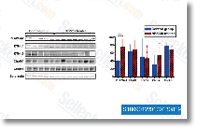Of note, the defined CD45 lin CD184 and CD45 lin CD184 SC populations have not been previously evaluated in rela tively long run prospective observation in PB of pre phrase infants. This examine demonstrated for the first time the num ber of primitive non HSCs circulating in CB is inversely related with the birth fat of premature infants. Our observations imply that during the fetal stage of human lifestyle, primitive, undifferentiated stem cells circulate in the blood in a significant amount and contribute to organ tissue formation. Gradually, the amount of non HSCs decreases and stabilizes in conjunction with the infants maturation. The characteristics selleck chemical Telatinib with the actually analyzed non HSCs corres pond with incredibly smaller embryonic like SCs expres sing pluripotent SC markers, described lately in CB by Kucia et al, with a contribution by our research workforce.
It has been demonstrated in mice that VSELs reveal pluri potency and are capable of form all sorts of mature cells. Additionally, following the amount of molecular ana lyses and in vivo experiments carried out by Ratajczak et al, it has been just lately proposed that human CB derived VSELs correspond on the population with the most primitive HSCs circulating kinase inhibitor URB597 during the PB. Hence, if a tiny premature infant loses a considerable number of cir culating non HSCs, enriched in VSELs, together with secundines, this could possibly properly have damaging clinical conse quences for the infants improvement inside the long-term. As we and other individuals have recently reported, VSELs are mobi lized during the PB of patients with ischemic stroke, myocar dial infarction, or hefty burns, and this maximize during the quantity of circulating cells is accompanied by elevated plasma levels of SDF 1.
It has been hypothesized that these cells could try to regenerate the broken tis sue. Whilst we didn’t observe strict evidence of an analogous phenomenon within this study, nevertheless the num ber of non HSCs VSELs circulating in PB of premature infants was substantially better than  in full term babies two weeks just after delivery. In the similar time level, SDF 1 plasma levels in preterm infants had been considerably higher in contrast to the preliminary concentration of this chemokine at premature birth. Noteworthy, we noticed a powerful correl ation amongst CB SDF one ranges as well as variety of non HSCs VSELs two weeks soon after delivery. Collectively, these observations might recommend that very similar pathophysiological responses observed in stroke individuals are observed in little premature infants in an attempt to keep PB derived non HSCs in somewhat higher concentrations. So as to clarify whether and how the undifferentiated non HSCs VSELs actively help regeneration inside the 1st handful of weeks of human existence immediately after birth, or whether or not they remain largely inside a dormant state, further studies are essential.
in full term babies two weeks just after delivery. In the similar time level, SDF 1 plasma levels in preterm infants had been considerably higher in contrast to the preliminary concentration of this chemokine at premature birth. Noteworthy, we noticed a powerful correl ation amongst CB SDF one ranges as well as variety of non HSCs VSELs two weeks soon after delivery. Collectively, these observations might recommend that very similar pathophysiological responses observed in stroke individuals are observed in little premature infants in an attempt to keep PB derived non HSCs in somewhat higher concentrations. So as to clarify whether and how the undifferentiated non HSCs VSELs actively help regeneration inside the 1st handful of weeks of human existence immediately after birth, or whether or not they remain largely inside a dormant state, further studies are essential.
IKK signal
IKK is an enzyme complex
